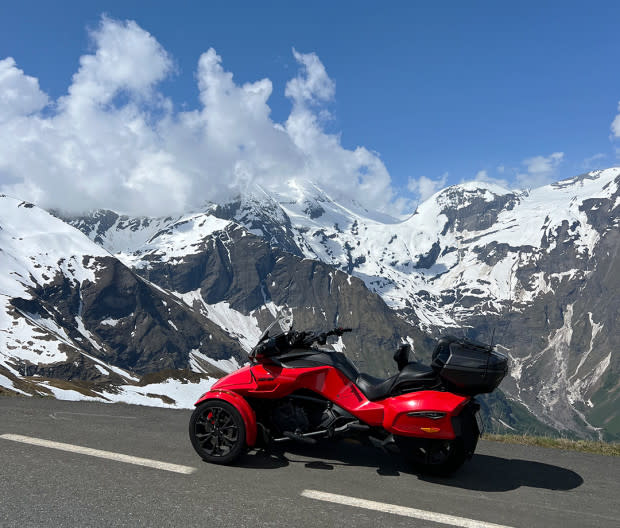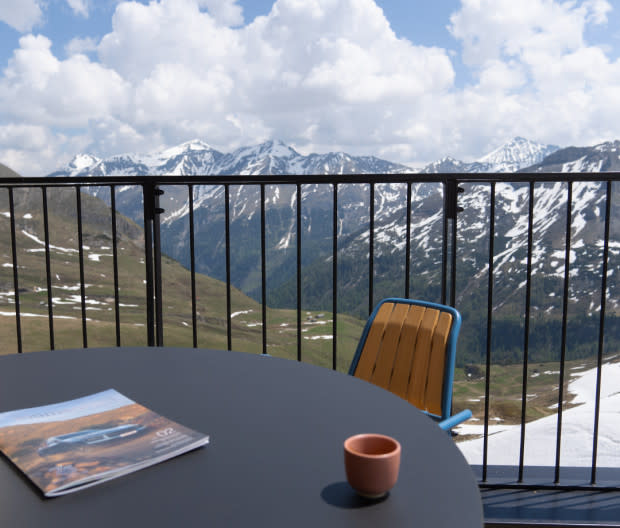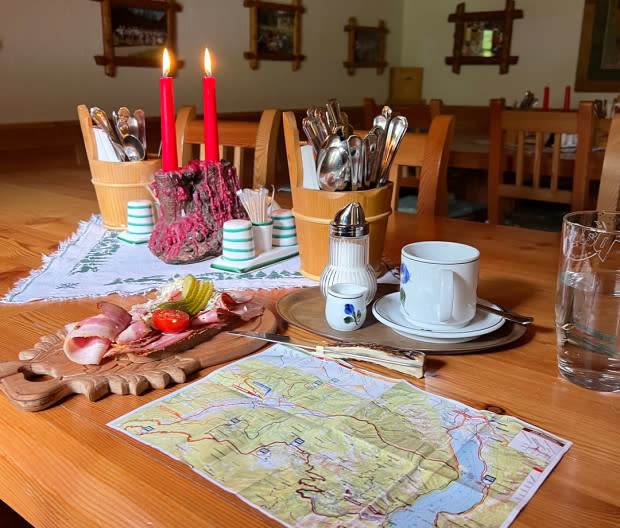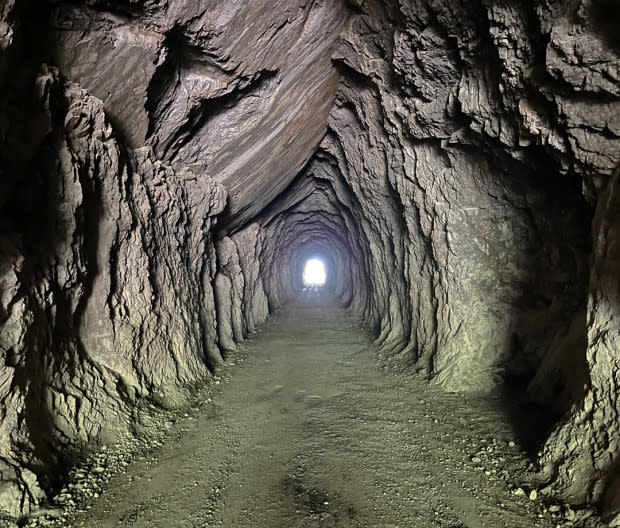Ultimate Alpine Run: Why Grossglockner, Europe’s Highest Paved Road, Is Best Braved on Three Wheels
Songbirds start tuning up well before sunrise in the Austrian Alps. By the time light breaks over cragged peaks, a full chorus explodes in echoic rhapsodies loud enough to replace any alarm clock. The hills have come alive, you might say, but I’ve been awake the whole time. Blame it on jet lag or, more likely, my long to-do list before the day’s agenda: a ride up the Grossglockner High Alpine Road—the highest paved road in Europe.
I’m in Austria to not only witness one of the world’s most unexpected gatherings—a group of over 300 Can-Am three-wheeler enthusiasts who attempt the so-called Grossglockner Challenge every year—but also to join in on the fun. I'll be straddling one of these peculiar triangular motorcycle-automobile amalgamations for the very first time in a very specific place on a very singular occasion.
This year marks the Grossglockner Challenge’s tenth running, drawing solo riders and two-ups from far and wide across Europe. Pre-Challenge prizes announced at an evening dinner include the longest rides to actually attend the event—with the top distance measuring a whopping 5,001 kilometers from the U.K. The highest odometer reading on any Can-Am present? Also impressive, at 143,000 kilometers.
Personally, I probably could've used a few thousands klicks to acclimate to the peculiarities of my new three-wheeled ride. Instead, I arrive in the Traunsee region south of Gmunden, about halfway between Munich and Vienna, then hop right on—wearing full moto gear for the first loop, just in case. By the time the group caravans to the base of Grossglockner, I feel almost ready for a steep, tight, and technical Alpine sprint.

Michael Teo Van Runkle
Taking the High Road
Construction on Grossglockner High Alpine Road began on August 30, 1930. The ribbon of asphalt reaches two passes, at the highest point just over 2,500 meters in elevation (just over 8,200 feet). Our planned route traces 21 miles from a toll booth south of Zell Am See to the Kaiser-Franz-Josefs-Höhe visitor center.
As a testament to Can-Am’s capabilities, that distance and almost 6,600 total vertical feet of climbing flies by surprisingly quickly. We buzz past cars, trying not to get too close to the brave cyclists enduring oxygen deprivation, and haul around the Grossglockner switchbacks at a pace I never thought the Spyders and Rykers could manage.
A few Porsches, Ferraris, and even a group of classic Alfa Romeos try to keep up—but the motorcyclists leave us done and dusted. These three-wheeled machines have a snowmobile chassis and use handlebars, but handle nothing like a motorcycle. There's no leaning or counter-steering required, though I find myself putting weight onto my inside foot trying to combat the strange centripetal sensation of turning without any tilt.
Related: Kickstart Your Year: The Best New Motorcycles of 2023
By the top of the first false summit, I find a flow and stop to snap a few pics of the snowy peaks all around. Then I cruise down a short few kilometers to F.A.T Mankei, a mountain hut that just reopened, serving espresso and sandwiches to the 900,000 or so tourists who visit the Grossglockner each year.
The restaurant’s charming, simple building also houses a F.A.T. International livery Porsche 962 that raced at Le Mans in a small atrium next door—and, of course, a few Porsches parked in the lot nearby.

Michael Teo Van Runkle
After re-upping my espresso buzz, I hop back on the Can-Am and blast farther up the hill towards a deep, dank tunnel that cuts a few vertical feet from the next saddle summit. A steep drop in elevation leads toward a visitor center, overlooking a crystalline glacier lake below the Grossglockner proper, the tallest mountain in Austria and the entire Alps at 12,461 feet.
In the shadow of towering mountaintops, weather often turns unpredictable. Luckily, part of my to-do list this morning includes checking multiple website and app forecasts. So, when temps start to approach freezing after peaking over 80 degrees Fahrenheit earlier in the day, I pull out plenty of layers. While pausing for a group photo and more espresso, I feel the first few drops of rain. Just a few hundred feet higher, gusts of snow begin swirling ominously.
Battling now-frigid temperatures in light rain poses a stark contrast to the previous day’s activities. We weathered scorching temps through traffic in Linz on the way to visit the Rotax factory and raced electric go-karts. Rotax builds Can-Am's three-wheeler engines, but also aims to lower the barrier of entry for the next generation of shifter kart racing—which, in Europe, always provides the foundation for future Formula 1 and rally pros.
As we drop back down Grossglockner, the cold, wet weather also reveals the Can-Am three-wheeler's stellar stability in slippery conditions, at least compared to two-wheeled cyclists and motorbikes. One has already taken a tumble on a relatively flat, straight section of wet road. A newbie like me manages to whip the Can-Am around with confidence despite the conditions, even if I've spent a decent amount of time overwhelmed with motorcycle envy.

Michael Teo Van Runkle
Switching to Two-Wheeled Fun
The next day, I pack some two-wheel fun into my travel schedule, if not on the Grossglockner itself. I'd originally hoped to rent a road bike and test oxygen deprivation by attempting the three-hour-plus climb, but foul weather looks likely to continue for the next several days—with forecasts of snow and temps in the low 30s at summit. Staying at lower elevations, I rent a Scott Axis eRide mountain bike from a shop called Sport Jirka in nearby Gosau, where owner Jirka Senk installs my Speedplay pedals on the electric mountain bike, slips me a pump and spare water bottle, and shares a map of nearby trails through the woods.
In Eco mode the whole time, which essentially negates the additional weight of the e-bike’s battery and motor, I follow the map’s dotted dirt lines and work my way up into the mountains. The tiny town of Gosau draws tourists eager to take in stunning vistas while hiking around the small lake of Gosausee, tucked at the base of steep canyons.
Related: 17 Best Summit Beers to Drink After Hiking and Mountaineering
Before I reach Gosausee on my circuitous adventure, though, I follow Senk’s advice and visit Rosalm Hutte, one of many Alpine mountain huts dotting his map. Some of these huts operate akin to Scottish bothy houses, providing free shelter for hikers and bikes, but others serve full meals, coffee, teas and, of course, schnapps. With more climbing ahead, I stick to an open-faced sandwich of cured meats rather than indulging in the local zirbenz, or stone pine liqueur—though when the rain starts on my descent to Gosausee, I'm pining for that spicy warmth in my belly.
After returning the e-bike, I warm up with a hearty bowl of Bratstrudel soup at the nearby Gosauerhof. Essentially a meat roll soaked in beef broth, this local favorite caters perfectly to the shivering, damp traveler who brought foul-weather motorcycle gear but only spandex to wear on the bicycle.

Michael Teo Van Runkle
Navigating Alpine Quirks
Food, in general, I've found to be hit or miss in Austria. A highlight includes a big salad topped with locally caught grilled fish—of "various kinds" is the most I glean from the waiter—between many a steak fillet and sausage. A glass of wine from the region usually runs about $3.50 to $5 and is typically on the drier, bitter side. Finding a better breakfast than pastries and coffee is a struggle in the smaller towns of the Alps. Just about every establishment still closes on Sundays—and even Mondays—leaving me to choose between gas station food and hotel restaurants. Next time, I’ll be a certified Alps professional and shop for groceries on Saturday.
Overall, the pastoral setting lends a supremely safe and secure spirit throughout Alpine towns I visit. Here, residents routinely leave bikes unlocked outside. Lines at buffets and stores are virtually unheard of in Austria, where I find you have to adapt to more of a free-for-all scrum mentality and roll with the elbows. Perhaps most annoying, slow vehicles on roads never pull over—neither farm implements rumbling along in the single-digits nor a Volkswagen Jetta pulling a horse trailer with literally hundreds of vehicles in a mile-long chain inching behind.
One last important caveat for all visitors to the Alps, and Austria, in general: The speed limit is the speed limit. One of the Can-Am club members got a ticket near his hotel going only 5kph over the posted sign, which is only 3mph too fast.
Related: The Best Mountain Towns in America and Beyond
This comes as an even greater surprise to me, having driven to the Alps from Munich in a Hyundai I30 N Line rental car, which I took up to its top speed of 207kph (128mph) on an unrestricted part of the German Autobahn. Even going 128, more powerful cars flew by going easily 30 to 50 mph faster. Back home, about a month later, I'll receive a €30 ticket on the Hyundai rental for going only 6 kph over the speed limit—as caught by an Austrian traffic camera!
In stark contrast to the excellent German roads, Austria also requires a so-called “vignette” for any vehicle that drives on highways. This sticker costs €9.90 (about $11 depending on exchange rates) for 10 days of highway access, and is only sold at certain gas stations and post offices. I end up purchasing a vignette just in case, but spend most of my time hustling the little Hyundai hatchback up the steepest winding roads I can spot on a map, above lakes and streams fed by snowpack still melting in the burgeoning summer weather.

Michael Teo Van Runkle
The farther east I drive, the higher the temps rise. So, after two nights based in Gosau, I decided to stop for a nice hike on the steep eastern shore of Traunsee. Divergent trails with well-defined signage (albeit in German) indicate where I might not need climbing ropes, but as I scale another few thousand feet of elevation between thickets of densely packed forest, plenty of other hikers scrabble up the vertiginous cliffs fully equipped with ropes and harnesses. Surprisingly, the trail includes three long, dark tunnels blasted into the rock face—somewhat haunting as the air turns cold and damp once more.
My legs end up pretty sore after riding the Can-Am, climbing about 3,000 feet in 40 miles on the e-mtb, then hiking up a steep lakeside mountain. The Austrian Alps reward such work with stunning sunsets above weathered peaks and glistening mountain lakes around every bend. The sun stays up well past 9 p.m. in summer months—perfect for recovery meals and drams of zirbenz on decks overlooking stupendous valleys.
As I drive the Hyundai east to Vienna, I'm looking forward to time in a city where grocery stores, restaurants, and bars stay open round the clock. When I arrive, I find that I miss those Austrian Alps—and notice a sequel already cropping up in my imagination. With a bit more planning and the knowledge gleaned from my first alpine adventure, I will return to ride a road bike, motorcycle, and Porsche in succession up the Grossglockner High Alpine Road.
It might not be the road less traveled, but it's certainly a road worth traveling.
